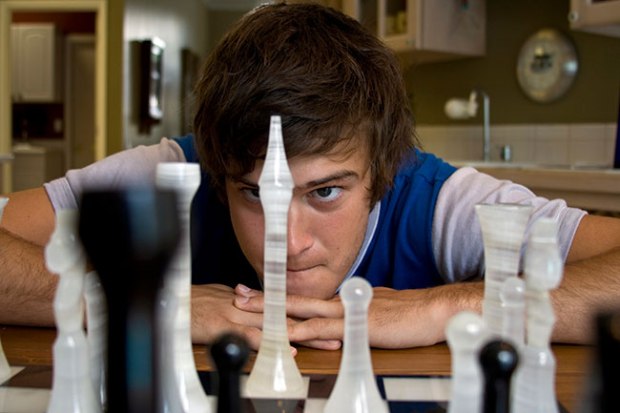10 Tips to Become a Chess Champ

To master chess strategies and become a chess champ, it’ll take lots of learning and practice. Here are 10 chess tips to get you started.
LEARN THE CHESS MOVES
Each chess piece can move only a certain way. For instance, a pawn moves straight ahead but can only attack on an angle, one square at a time. A knight’s move is L-shaped. The bishop moves at an angle but can move more than one square at a time. The rook (castle) can move only in a straight line but can go forward, back or to the side. The queen, the most powerful piece, can move in any direction for any number of squares, but not two directions in one move. And the king moves at a stately pace — as a king should — one square at a time in any direction on the chess board.
OPEN WITH A PAWN
Move the pawn in front of either the king or queen two squares forward. (Only on its opening move can a pawn move two squares.) This opens pathways for your bishops and queen to enter the game. They move on an angle and can’t get out onto the field of battle if pawns are in the way.
GET THE KNIGHTS AND BISHOPS OUT
Before you move your queen, rooks or king, move your knights and bishops toward the center of the chess board. You want to get these pieces out from behind the pawns so they can attack.
WATCH YOUR BACK!
And front! When it’s your turn, always think to yourself, “What did my opponent’s last move do? What is he up to?” Is he laying traps to capture your pieces? Then decide on your own plan. Always look at all your possibilities. Look at moves that would capture your opponent’s men or threaten his king first. But always double-check your moves before you play them. Ask yourself, “Does my move leave something unprotected?”
DON’T WASTE TIME
Don’t make too many moves with your pawns or try to pick off your opponent’s pawns.
“CASTLE” EARLY
Castling is a move that allows you to move your king to safety and bring your rook into play. Once all the squares between your rook and the king are unoccupied you can move the king two squares toward the rook while the rook moves to the square on the the king’s other side. If your opponent neglects to castle, you might be able to launch an attack on his king. This is the only chess move in which more than one piece may be moved in a turn.
ATTACK IN THE “MIDDLEGAME”
After you’ve brought all your knights and bishops into the game and castled (these moves are your “opening”), the middlegame begins. In the middlegame, always be on the lookout for ways to capture your opponent’s men. Take any chess piece that your opponent doesn’t protect. But look at what will happen to your piece if you take his — will you get picked off? Always be looking for ways to move lots of your men into position to attack the enemy king.
LOSE PIECES WISELY. IT’S AN ESSENTIAL CHESS STRATEGY
You’ll take some of your opponent’s pieces. Some of your pieces will be taken. You must figure out what is and isn’t a good swap in chess. This is one of the most important chess strategies.
Use these points to figure out whether you’re making a good move if you’re going to lose one of them:
- Queen: 9 points
- Rook: 5 points
- Bishop: 3 points
- Knight: 3 points
- Pawn: 1 point
So is it a good idea to lose a bishop to save a pawn? No!
DON’T PLAY TOO FAST
If you see a good move, sit on your hands and look for a better one. Patient thinking is the key to chess success.
WIN THE ENDGAME
After you and your opponent swap pieces and you’re down to just a few men, the endgame begins. Now the pawns become more important. If you can advance a pawn to the farthest row away from you, that pawn becomes a queen. A big success! Let your king attack, too, as long as he stays out of reach of your opponent’s remaining pieces — especially the queen — and does not let himself to be checked.
Your king is said to be in check when your opponent threatens to use one of his pieces to capture the king on his next move. If your king is checked and you have no way to remove the threat — it can’t run away, you can’t capture the opposing piece that has him in check and you can’t block the check by moving one of your own pieces — the game is lost. Checkmate! If you checkmate your opponent before he checkmates you, then you win!
By using these chess strategies and tips, you’ll become a chess champ in no time!
wow those are really good tips
wow
Thx for such awesome tips! I am a big fan of chess, although I am not the best player in a game. I cannot wait to give all 10 of these tips a try. Thanks a ton!!!
Very nice …thanx
A great defensive opening is to leave the three pawns on the right side of you and then castle behind them this will protect your king very well.
Yeah but it also traps him. all your opponent would have to do is put a rook on your row and the games over
I,ve been trying to checkmate my dad but he always beats my secret skills! i hope these tips come in handy!!!
Same with me
nice stuff
nice game and i like that tips
nice step’s
These tips are mostly common sense but the point system and tactics were really helpful. Too bad I won’t think of them when I’m actually playing :/